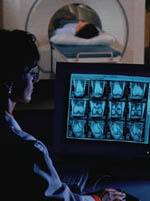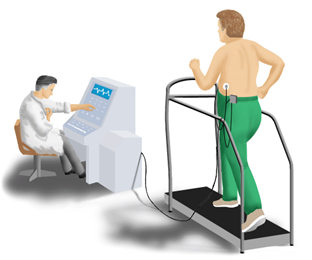Radionuclide Angiogram, Resting and Exercise
What is a resting and exercise radionuclide angiogram (RNA)?
A resting and exercise radionuclide angiogram (RNA) is a type of nuclear medicine test. This means that a tiny amount of a radioactive substance, called a tracer, is used to help show the tissue under study. In this test, doctors study the heart's chambers in motion. This test can tell the doctor how well the heart pumps and how much blood it pumps with each heartbeat (called the ejection fraction) both during exercise and at rest.
Your doctor injects a radioactive tracer (usually technetium) into an arm vein to "tag" blood cells so he or she can track their progress through the heart with a scanner. A special camera (called a gamma camera) then records the heart muscle at work, like a movie. Your doctor can match these recordings with the electrocardiogram (ECG), a recording of the heart's electrical activity.
An RNA test with rest and exercise is done so the doctor can assess the heart's function during exercise and compare it to how well the heart works at rest. If the heart muscle does not move in a normal way, or not enough blood is pumped out by the heart, it may be a sign of one or more of the following:
-
Injury to the heart muscle, possibly as a result of decreased blood flow to heart muscle due to clogged heart arteries
-
An enlargement of one or more of the heart's chambers
-
Aneurysm (a weak area in the heart muscle)
-
Toxic effects of certain medicines
-
Heart failure
Other related procedures that may be used to assess the heart include resting or exercise electrocardiogram (ECG or EKG), Holter monitor, signal-averaged ECG, cardiac catheterization, chest X-ray, computed tomography (CT scan) of the chest, echocardiography, electrophysiological studies, magnetic resonance imaging (MRI) of the heart, myocardial perfusion scans, and cardiac CT scan.
Why might I need an RNA?
Reasons for your doctor to request a resting and exercise radionuclide angiogram (RNA) include:
-
Chest pain
-
Shortness of breath
-
Dizziness
-
Fatigue (extreme tiredness)
If a screening exam (such as an electrocardiogram or ECG) suggests some type of heart disease that needs to be explored further, a resting and exercise RNA may be done.
There may be other reasons for your doctor to recommend resting and exercise RNA.
What are the risks of an RNA?
The amount of the radioactive tracer your doctor injects into your vein for the test is very small. So, there is no need for precautions against radiation exposure.
The injection of the radioactive tracer may cause some slight discomfort. Allergic reactions to the tracer are rare.
If you are pregnant or think you could be, tell your healthcare provider. There is risk of injury to the fetus from this test. Radiation exposure during pregnancy may lead to birth defects. If you are lactating, or breastfeeding, tell your healthcare provider due to the risk of contaminating breast milk with the radionuclide.
There may be other risks depending on your specific medical condition. Be sure to discuss any concerns with your doctor before the test.
Certain factors may interfere with or affect the results of this test. These include:
-
Caffeine intake within 48 hours of the procedure
-
Smoking or using any form of tobacco within 48 hours of the procedure
-
Certain heart medicines
How do I prepare for an RNA?
PLEASE NOTE: Nicotine in cigarettes may cause spasm in the coronary arteries, which could affect the test results.
Notify your doctor and when you schedule the exam if you have a pacemaker.
PRECAUTIONS: If you are pregnant or think you may be pregnant, please check with your doctor before scheduling the exam. We will discuss other options with you and your doctor.
BREASTFEEDING: If you are breastfeeding, you should notify your health care provider due to the risk of contaminating breast milk with the tracer.
CLOTHING: You may be asked to change into a patient gown. A gown will be provided for you. Lockers are provided to secure your personal belongings. Please remove all piercings and leave all jewelry and valuables at home.
Please to wear loose, comfortable clothing for the exercise portion of the test, as well as a comfortable pair of shoes.
EAT/DRINK: Fasting may be required before the procedure. You will be given specific instructions as to how long you should withhold food and/or liquids when you schedule your appointment.
ALLERGIES: Notify the radiologist or technologist if you are allergic to or sensitive to medications, contrast dyes or iodine. The injection of the radiotracer may cause some slight discomfort. Allergic reactions to the radiotracer are rare, but may occur.
MEDICATIONS: Please bring a list of all medications (prescription and over-the-counter) and herbal supplements that you are taking.
Based on your medical condition, your doctor may request other specific preparation.
What happens during an RNA?
A resting and exercise radionuclide angiogram (RNA) may be done on an outpatient basis or as part of your stay in a hospital. Steps may vary depending on your condition and your doctor's practices.
Generally, a resting and exercise RNA follows this process:
-
You will be asked to remove any jewelry or other objects that may interfere with the test.
-
You may need to change into a hospital gown.
-
A healthcare professional will start an intravenous (IV) line in your hand or arm.
-
A nurse will connect you to an ECG machine with leads that stick to your skin and a blood pressure cuff will be placed on your arm.
-
You will lie flat on a table in the procedure room.
-
Your doctor will inject the radioactive tracer into the vein to "tag" the red blood cells. You will probably not feel anything when the tracer is given.
-
As another option, a small amount of blood may be withdrawn from your vein so that it may be tagged with the tracer. The tracer will be added to the blood and will be absorbed into the red blood cells, then the blood will be returned into your vein through the IV.
-
During the test, it will be very important for you to lie as still as possible, as any movement can affect the quality of the scan.
-
Your doctor will position the gamma camera over you as you lie on the table and will track the progress of the tagged red blood cells through your heart.
-
The gamma camera will record images of your heart as it pumps the tagged blood cells through your body.
-
You may be asked to change positions during the test; however, once you have changed position, you will need to lie still without talking.
-
After the resting scan is done, you will be asked to exercise on a treadmill or stationary bike. If you notice any discomfort, such as chest pain, dizziness, headache, shortness of breath, or extreme fatigue while exercising, let the technologist or doctor know right away.
-
You will exercise until you have reached your target heart rate (determined by the doctor based on your age and physical condition), or until you are unable to continue due to chest pain, leg pain, severe shortness of breath, or severe fatigue (tiredness).
-
Immediately after exercise, you will lie on the table while your doctor records a second set of images.
-
Once all the heart images are done, your vital signs (heart rate, blood pressure, and respiration rate) will be monitored for a period.
-
A healthcare professional will remove the IV line, and you will most likely be able to leave, unless your doctor tells you differently.
What happens after an RNA?
Move slowly when getting up from the scanner table to avoid any dizziness or lightheadedness from lying flat for the length of the test.
Drink plenty of fluids and empty your bladder often for 24 to 48 hours after the test to help flush the remaining radioactive tracer from your body.
A nurse will check the IV site for any signs of redness or swelling. If you notice any pain, redness, or swelling at the IV site after you go home, tell your doctor as this may be a sign of infection or other type of reaction.
Your doctor may give you other instructions after the test, depending on your situation.




